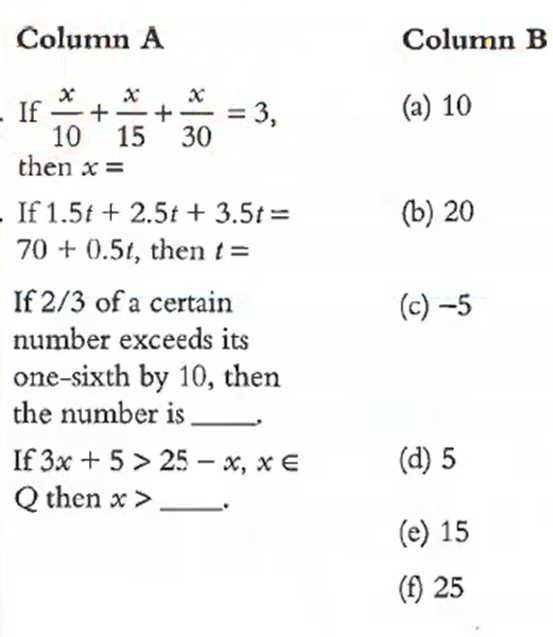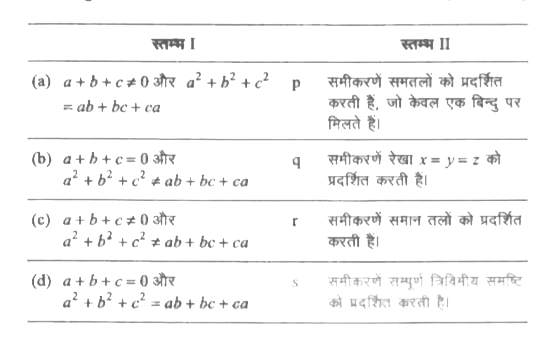Consider the linear equations ax+by+cz=0,bx+cy+az=0andcx+ay+bz=0.
Match the conditions/expressions in Column I with statements in Column II.
 Solution in Tamil
Solution in Tamil
The correct Answer is:a→r;b→q;c→p;d→s
Here we have the determinant of the coefficient matrix of given equation as
Δ=∣∣
∣∣abcbcacab∣∣
∣∣
=−(a+b+c)(a2+b2+c2−ab−bc−ca)
=−12(a+b+c)[(a−b)2+(b−c)2+(c−a)2]
a. a+b+c≠0
and a2+b2+c2−ab−bc−ca=0
or (a−b)2+(b−c)2+(c−a)2=0
or a=b=c
Therefore, this question represents identical planes.
b. a+b+c=0
and a2+b2+c2−ab−bc−ca≠0
This means Δ=0anda,bandc are not all equal. Therefore, all equations are not identical but have infinite solutions. Hence,
ax+by=(a+b)z (using a+b+c=0)
and bx+cy=(b+c)z
⇒ (b2−ac)y=(b2−ac)z⇒y=z
rArr ax+by+cy=0⇒ax=ay
⇒ x=y=z
Therefore, the equations represent the line x=y=z.
c. a+b+c≠0anda2+b2+c2−ab−bc−ca≠0
⇒ Δ≠0 and the equations have only trivial solution, i.e., x=y=z=0.
Therefore, the equations represent the planes meeting at a single point, namely origin.
d. a+b+c=0anda2+b2+c2−ab−bc−ca=0
⇒ a=b=candΔ=0⇒a=b=c=0
⇒ All equations are satisfied by all x,yandz.
⇒ The equations represent the whole of the three-dimensional space.
Topper's Solved these Questions
- THREE-DIMENSIONAL GEOMETRY BOOK - CENGAGECHAPTER - THREE-DIMENSIONAL GEOMETRY EXERCISE - Exercise (Numerical)
10 Videos
- THREE DIMENSIONAL GEOMETRYBOOK - CENGAGECHAPTER - THREE DIMENSIONAL GEOMETRYEXERCISE - Question Bank
12 Videos
- TRIGNOMETRIC RATIOS IDENTITIES AND TRIGNOMETRIC EQUATIONSBOOK - CENGAGECHAPTER - TRIGNOMETRIC RATIOS IDENTITIES AND TRIGNOMETRIC EQUATIONSEXERCISE - Question Bank
4 Videos
Similar Questions
Find the number of sphere of radius r touching the coordinate axes.
View SolutionThe equation of the plane which has the property that the point Q(5,4,5) is the reflection of point P(1,2,3) through that plane, is ax+by+cz=d where a,b,c,d∈N. Find the least value of (a+b+c+d).
View SolutionThe number of solution (s) of the equation
√2+cos2x=(sinx+cosx)∈[−π2,π]
View SolutionConsider the linear equations ax +by+cz=0,bx+cy+az=0 and cx+ay+bz=0
View SolutionMatch the following Column A to Column B

View SolutionConsider the following linear equations ax+by+cz=0,bx+cy+az=0,cx+ay+bz=0
View SolutionMatch the followings (column I with column II)
ltimg src="https://d10lpgp6xz60nq.cloudfront.net/physics_images/NCERT_BIO_XI_C03_E01_011_Q01.png" width="80%"gt
View SolutionMatch the terms in column I with those in column II: ltimg src="https://d10lpgp6xz60nq.cloudfront.net/physics_images/NCERT_BIO_XI_C07_E01_011_Q01.png" width="80%"gt
View SolutionMatch column I with column II
ltimg src="https://d10lpgp6xz60nq.cloudfront.net/physics_images/NCERT_BIO_XI_C16_E01_002_Q01.png" width="80%"gt
View SolutionMatch column I with column II:
ltimg src="https://d10lpgp6xz60nq.cloudfront.net/physics_images/NCERT_BIO_XI_C18_E01_003_Q01.png" width="80%"gt
View SolutionMatch the items of column I with those of column II: ltimg src="https://d10lpgp6xz60nq.cloudfront.net/physics_images/NCERT_BIO_XI_C19_E01_011_S01.png" width="80%"gt
View SolutionMatch Column I with Column II: ltimg src="https://d10lpgp6xz60nq.cloudfront.net/physics_images/NCERT_BIO_XI_C20_E01_010_Q01.png" width="80%"gt
View SolutionMatch the items given in column A and B: ltimg src="https://d10lpgp6xz60nq.cloudfront.net/physics_images/NCERT_BIO_XII_C16_E01_004_Q01.png" width="80%"gt
View SolutionConsider the following linear equations ax+ by + cz=0, bx + cy + az =0, cx+ ay +bz=0
View Solutionमाना रैखिक समीकरणों ax+by+cz=0,bx+cy+az=0 तथा cx+ay+bz=0 हैं।
स्तम्भ I में दिए गए प्रतिबन्धों /व्यंजकों का स्तम्भ II में दिए गए कथनों के साथ सुमेल करायें।

View SolutionConsider the linear equations ax+by+cz=0,bx+cy+az=0andcx+ay+bz=0.
Match the conditions/expressions in Column I with statements in Column II.

View Solution